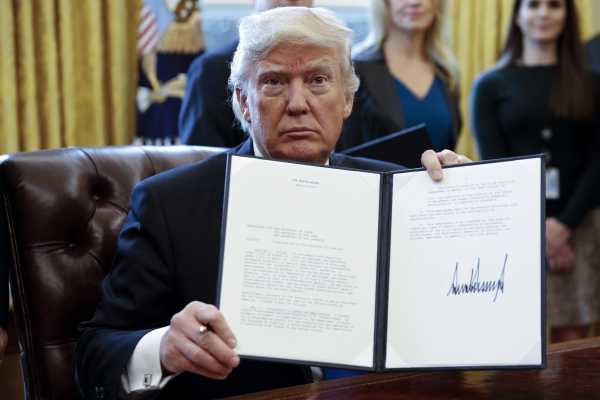
President Donald Trump has found a new preferred metric for his presidency now that the stock market has become so tumultuous: oil prices.
Trump spent much of the first two years of his term taking credit for the stock market’s run, bragging about adding trillions of dollars in wealth and predicting the Republican tax cut bill would push stocks even higher. But markets have faltered as of late, with major US stock indices giving back most of their 2018 gains.
So Trump has pivoted to a new metric and has taken to boasting about how he’s keeping oil prices low. He’s fired off multiple tweets about it in recent weeks.
“So great that oil prices are falling (thank you President T),” he tweeted over Thanksgiving weekend.
Ahead of the holiday, he made a tongue-in-cheek apology for keeping gas prices so low that he caused traffic jams. He also took a swipe at the “Fake News Media” for not crediting him.
The same day, he thanked Saudi Arabia for low oil prices in a tweet. It was the day after he said in a statement that he would stand by Saudi leadership despite evidence that it was behind the murder of journalist and dissident Jamal Khashoggi in October.
But just like pegging his presidency to the stock market, tying it to the price of oil is a bad idea, because there’s a lot going on that has nothing to do with him.
“There are so many variables that go into oil prices, almost none of which are under his control, that taking credit for a price drop will inevitably backfire when the price rises again,” Ashley Petersen, a senior oil market analyst at the energy advisory firm Stratas Advisors, told me.
And while low oil prices may make consumers happy because they keep gas prices down, they’re not exactly a thrill for the oil and gas industry — another key Trump constituency.
Some of what’s up with oil prices has to do with Trump. But not really good things.
In October, oil was trading at upward of $80 a barrel, causing speculation it could go as high as $100. But in recent weeks, things have shifted, and it’s now at about $50.
As the Wall Street Journal’s Sarah McFarlane and Pat Minczeski laid out on Tuesday, there are a number of factors at play. The global supply of oil is outpacing demand right now, oil inventories (basically, the amount of oil in storage) are on the rise, and the US is increasing how much oil it’s pumping. There’s also more Iranian oil in the market than expected, and Russia and Saudi Arabia have been ramping up production as well.
Most of that has nothing to do with President Trump. Some of it does, but not exactly in a positive way.
The main Trump-related factor is, perhaps surprisingly, Iran. Trump withdrew the US from the Iran deal last spring and reimposed sanctions on the country this month, but with a caveat: The US granted waivers to eight countries letting them at least temporarily keep buying oil from Iran, including China, India, and South Korea. The waivers are fairly open-ended, Peterson said, and they don’t have specifications about wind-down periods or volumes.
Trump had already been pushing Saudi Arabia to keep its supply up — presumably to help make up for the difference if the supply from Iran were to be cut off. But since Iranian oil isn’t off the market, he has instead triggered concerns about oversupply.
Trump’s trade disputes aren’t helping either, because they could slow economic growth and, in turn, hurt demand. That’s pushing prices down too.
“You could say he helped lower oil prices, but he did it by being weaker than expected on a country he’s labeled as an enemy of America and by potentially derailing economic growth through a trade war with China,” Petersen said. “Not exactly bragging points.”
It’s not clear where oil prices are headed next. OPEC and its partners will meet in Austria on December 6, and according to Reuters, they are discussing a proposal to cut oil output in order to stop prices from dropping further. If Saudi Arabia, the de facto leader of OPEC, agrees to such a plan (Trump has been pressuring it not to), that would likely boost prices. Saudi Arabia and Russia could also try to convince Trump on production cuts at the G20 meeting this week in Argentina.
“I suspect that markets will be waiting to see what happens with the G20 and also with the OPEC meeting next week,” Petersen said. “Assuming OPEC strongly projects that they will maintain control over their supplies and not flood the market, prices should rise to a more reasonable $70- to $75-per-barrel range.”
Low oil prices are good for Trump, and they aren’t
Low oil prices are good for the populist version of Trump: They keep gas prices low, resulting in more money in consumers’ pockets. But for the industry-friendly version of the president, the scenario is more complicated. Trump has positioned himself as a champion of the oil and gas industry, many segments of which aren’t exactly thrilled with the low price of oil.
Jeff Currie, an analyst at Goldman Sachs, warned in an interview with CNBC this week that oil prices at $50, where they currently are, are a “barrel dig into the US industry’s cost structure” and “not good” for the country.
Helima Croft, the global head of commodity strategy at RBC Capital Markets, echoed the concern in a separate interview with the outlet.
“You have a situation where if President Trump really wants prices to continue to decline further, that is going to really hurt the US shale industry,” she said.
US drillers can better withstand low oil prices than their international competitors, especially since the US lifted its 40-year ban on exporting oil in 2015, under Trump’s predecessor, President Barack Obama. But they still don’t want them to stay low for too long.
Trump tying his presidency to things out of his control just isn’t a good idea
Wherever oil prices head next, or who it is or isn’t good for, Trump tethering his success to measurements he can’t really control is not the best way to govern. But this is Trump, so he often moves the goalposts, switches the metrics, or finds someone else to blame.
Trump has already pinpointed scapegoats for the stock market’s recent troubles. Soon after the midterm elections, he claimed on Twitter that markets were jittery because Democrats had taken back the House of Representatives. The month before, he pointed the finger at the Federal Reserve for raising interest rates.
WSJ reported over the weekend that Trump is now upset with Treasury Secretary Steven Mnuchin for the way things are going on Wall Street and “voiced displeasure” over stock market turbulence.
Some of the stock market’s post-2016 gains were Trump-related; some of them weren’t. The same goes for its recent declines. Whoever the president blames doesn’t make a difference.
And just like the stock market has eventually stopped doing what the president wants, so will oil prices. And we’ll be right back here.
Sourse: vox.com






